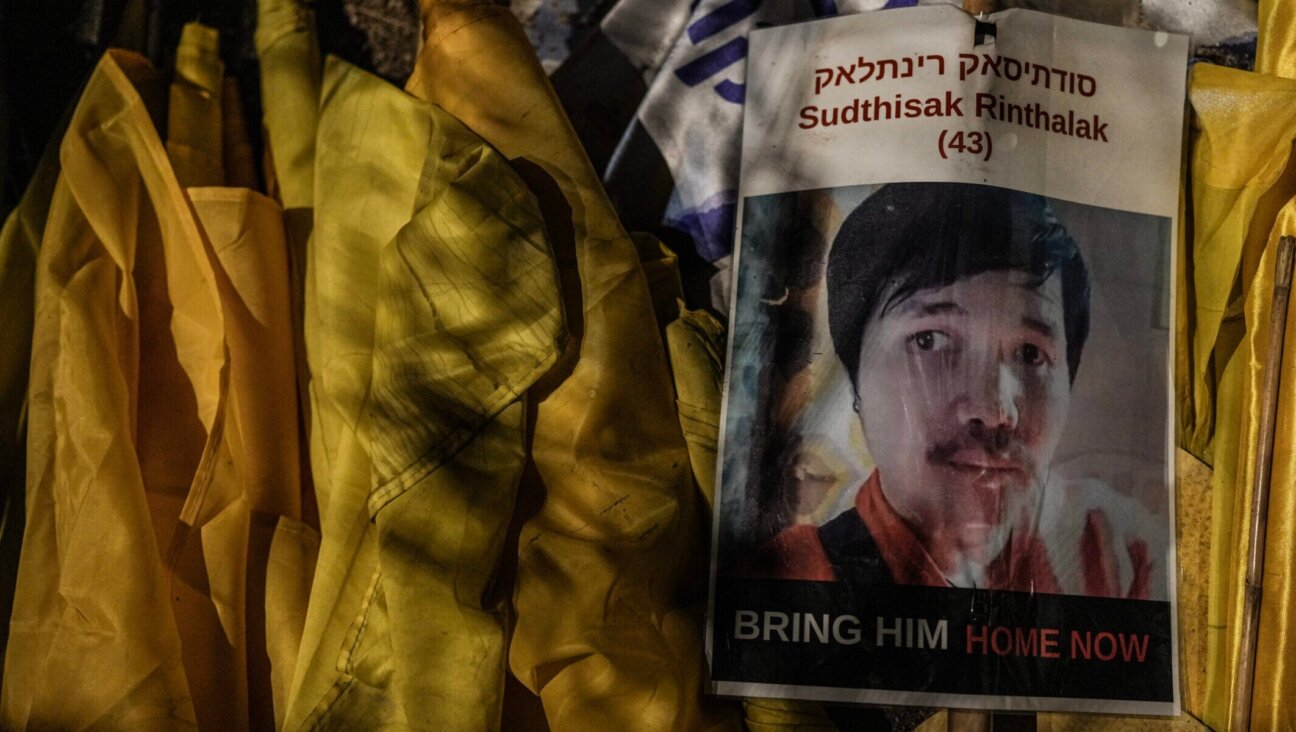Jewish Cookies Santa Would Love

Image by istock

Image by Hilary Ratner
As much as I loved Hanukkah growing up, I still had a bit of Christmas envy. It wasn’t the presents, tree or Santa I lusted after, but the cookie culture my Christian friends took part in. I was in awe of my friend’s family, the Lowes, who took such care in decorating their cookies that tweezers were used to lay silver sugar globes and sprinkles into intricate patterns. I wanted to camp out at the Collins’s house, where baking started weeks before the actual Christmas party.
To be sure, Jews have their cookies — hamantaschen for Purim, macaroons for Passover — yet these sweets are rarely thought of as the highlight of the Jewish baking world.
But perhaps they have been overlooked. Each of the sugary sweets on the list below tells a Jewish story — of war, assimilation or celebration. Like many Jewish foods, several of the cookies have more than one story of origin, often outside the Jewish community, and were adapted by Jews to suit holiday and kashrut needs.
Some of the cookies, like ghouribi, which were recently served at the White House, and macaroons, which are finally getting an artisanal makeover, are having their moment in the spotlight, while others, like kichelach, are in danger of fading into obscurity. The cookies span an immense timeline with the oldest dating back to the Roman Empire, and newest being born and retired in the 20th century.
So, while I won’t be putting out any cookies for Santa this season, I will be tucking these treats into my oven and enjoying a holiday cookie tradition of my own. With a tall glass of milk, for dunking, of course.
Share stories and recipes of your favorite Jewish cookies in the comments.

Image by COURTESY 'INSIDE THE JEWISH BAKERY'
Teyglech
Rosh Hashanah’s Quirky Cookie
If honey cake is the golden child of Rosh Hashanah desserts, consider teyglech — the sweet and sticky holiday cookies that are spiced with ginger and covered with nuts and dried fruits — the eccentric aunt. Unlike the rich and refined honey cake, which is meant to be eaten with a fork, these cookies are enjoyed by picking apart pieces. Teyglech — a Jewish version of caramel popcorn balls — actually means “bits of dough” in Yiddish. Jewish communities in Central Europe and Italy first made the dessert during Roman times, according to Gil Marks. They eventually made their way to America by way of Manhattan’s Lower East Side, where they lined the shelves of bakeries as early as the late 19th century, food historian Jane Ziegelman said. Perhaps the sweetest cookie on the list, teyglech are also the only cookies that are not baked. The bits of dough are cooked in honey, easily soaking up its sweetness. Teyglech are best eaten fresh, as they will become brittle if left on the shelf for too long.

Hamantaschen
The Purim Villain’s Hat, Pockets and Ears
Despite being one of the most familiar Jewish cookies, hamantaschen in name and symbolism are the most perplexing on the list. While Hebrew school children are taught that the triangular cookies represent Haman’s hat, their name actually means “Haman’s pockets” in Yiddish. In Israel, the cookies are called oznei haman, or “Haman’s ears.” But the word “hamantaschen” is a riff on the name of the German or Bohemian dessert mohntashen, said Joan Nathan. The poppy seed-filled pocket cookie, which was made with yeast dough, predates hamantaschen and was adopted by the Jewish community. While hamantaschen recipes originally called for poppy filling, Jews in France now fill them with Nutella. And in recent years, savory fillings have become increasingly popular among creative home bakers in the United States.

Image by QUENTIN BACON
Ka’ak bi’Loz
The Pre-Bath Syrian Treat
So elegant are these colorful, wreath-shaped cookies, they are fit for a queen. Or, in the case of Syrian tradition, a bride. A future mother-in-law gives Ka’ak bi’Loz, which represents fertility, to the bride at a swanee, a celebration in anticipation of the bride’s first trip to the mikveh. The custom of giving the sweet, along with perfumes, soaps, a silver or gold coin, and other items she will use at the mikveh, originated from the Arabs and was adopted by the Syrian-Jewish community, explained Poopa Dweck, author of the Syrian-Jewish cookbook “Aromas of Aleppo.” Ka’ak bi’Loz are made from almond paste and are sometimes dyed pink or green and adorned with a small rose made of icing. The cookies are so intertwined with Syrian customs that, Dweck says, communities around the globe have women whose “specialty [it is] to make them.”

Sfratti
Italy’s Eviction Stick
Sfratti, similar to hamantaschen, are a sugary embodiment of the saying “They tried to kill us, we survived, let’s eat!” In the 16th and 17th centuries, thousands of Italian Jews were expelled from their homes — some physically, with sticks — and forced to relocate to ghettos. The Jews of Pitigliano, in Tuscany, commemorated the horror with a log-shaped cookie stuffed with honey and nuts. “One of the things that makes us so resilient is that we remember [these events], but also move forward. A cookie is a good symbol of that,” Forward Ingredients columnist Leah Koenig said. Five hundred years later, sfratti, which means “evictions” in Italian, are still common in Tuscany. “They have [even] become a signature Christmas cookie,” Italian-Jewish food writer Alessandra Rovati said.

Ghouribi
North Africa’s Sugar Cookie
You may have never heard of these simple, fragile cookies that Moroccan Jews use to decorate their Purim tables, but ghouribi made their way to the White House not so long ago. “I made them for a luncheon with Zeke Emanuel.… He liked them so much, he called me [for the recipe] and made them for a meeting in the White House,” Joan Nathan said. The easy-to-make cookies were originally “buttery, almondy, floury Greek cookies, but Jews couldn’t use the butter, so they adapted them,” she added. Ghouribi call for only a few simple ingredients — often including oil instead of butter to make them pareve. While they hold a particular place in Moroccan-Jewish traditions, they’re also popular among Jews of other North African countries and in France (under the name Montecaos de Mamine, or Grandmother’s Melt-Away Cookies) at Hanukkah time and during the Sabbath.

Image by pETER DOM
Macaroons
The Dual-Identity Dessert
When I visited Paris in 2006, my host couldn’t wait for me to sample a macaron. To my pleasant surprise, the elegant, pistachio-cream-filled sandwich cookie was a far cry from the coconut mound I knew as a macaroon. While exceptionally different, the two cookies aren’t entirely unrelated, according to Joan Nathan. Jews in Spain ate the original macaroons, made with crushed almonds, egg whites and sugar. The dessert was so closely tied to the Jewish community that during the Inquisition, people purchasing the dessert were accused of being Jewish. Ultimately the cookies spread to France, where they were dubbed “macaroons” in the 16th century, according to Gil Marks in the “Encyclopedia of Jewish Food,” and then made their way to Eastern Europe. It wasn’t until Ashkenazi Jews brought them to America in the late 19th century and began baking them with coconut that they became a signature Passover dessert.
Only a generation or two later, pastry chefs at France’s famous Ladurée patisserie created the sandwich cookie known as the macaron with almond flour. Today, it’s not just the French cookie that gets the royal treatment: The New York-based baking company Danny Macaroons is elevating the humble coconut cookie to an artisanal dessert with flavors like red velvet and chocolate with sea salt.

Image by ALAN RICHARDSON
Rugelach
The Jewish Roll-Up Cookie
Whenever a member of my family goes to Israel, he or she is simply expected to return with a kilo of chocolate rugelach from Jerusalem’s famed Marzipan Bakery. The crescent-shaped cookies will stay in our freezer, being reheated one by one, until the next family member goes to Israel and fetches more. Also called kipfel, they are perhaps the most recognizable Jewish cookie in America. Some culinary historians, like Gil Marks, argue that the twisted dessert was the precursor to the French croissant and was created by Austrian bakers in celebration of the end of the Turkish siege of Vienna in 1793, as the shape looks like the symbol on the Ottoman flag. Others say the history of rugelach is a bit murkier. In Europe, according to Stanley Ginsberg, co-author of “Inside the Jewish Bakery,” bakers mixed sour cream into the dough, making the cookies a staple of the dairy-filled holiday Shavuot. American bakers replaced the sour cream with cream cheese, complementing the sweet fillings that range from cinnamon and nuts to jams and chocolate. In 2010, rugelach even inspired an ice cream flavor called “Ronne’s Rugelach” by Chozen, an upscale Jewish ice cream producer.

Mandel Bread
The Jewish Dunking Cookie
Mandel bread is often called “Jewish biscotti,” but it’s more like the chocolate chip cookie of the Jewish world. Nearly every Ashkenazi family has a recipe in its repertoire. Called mandelbroyt, or almond bread, in Yiddish, the cookies are baked twice — once as a loaf and once cut into biscotti-like slices — ensuring their signature crunch and long shelf-life. While similar to biscotti, mandel bread is typically softer and meant to be dipped in tea instead of in Italian coffee, wine or grappa. Cookbook author Joan Nathan speculates in her book “Jewish Cooking in America” that Jews from the Piedmont region in Northern Italy may have brought the idea of a twice-baked cookie with them to Eastern Europe, where mandel bread and its cousin, kamishbroyt, were created sometime after the Inquisition. While the dunking cookies were originally flavored with almonds, everything from chocolate chips to dried fruit to nuts has been mixed in to spice up the traditional recipe.

Image by WIKIMEDIA COMMONS
Hydrox
The Ultimate American Jewish Cookie
“All the cool cookies weren’t kosher back in the day, like Chips Ahoy! and Oreos. We had the counterfeit Oreos,” Eve Jochnowitz recalled. Generations of kosher-keeping American Jews grew up longing to taste the holy land of American cookies: the Oreo. Before Oreos went kosher, there were Hydrox — a crunchier version of the sandwich cookie, which made their debut in 1908, four years before Oreos hit the scene. Hydrox looked almost the same, but carried a stigma for some young Jews who associated the cookies with being outsiders. In 1997, when Oreos went kosher, Jewish children across the country rejoiced. A few years later, Hydrox faded into oblivion, or so it seemed. Around its 100th anniversary, in 2008, after receiving more than 1,300 phone calls and a petition that garnered 1,000 signatures, Kellogg’s, which then owned the brand, decided to do a special anniversary run. Hydrox has since disappeared from store shelves but the secret recipe can still reportedly be tasted in crumbled pie crusts and in Carvel ice cream cakes.

Image by DAVID SNYDER
Kichelech
The Elusive Plain Jane
Kichelech literally means “cookies” in Yiddish, and they are the simplest of the sweets on the list, able to be made with as few as four ingredients — eggs, salt, oil and flour. The crackerlike cookie can be dunked in milk, tea or coffee, and, as with most basic recipes, it can easily be adapted; while savory renditions made with onion or poppy seeds exist, the most well-known variety is the eyer, or egg, kichelech, which are topped with a crisp shell of granulated sugar and formed into a bowtie or square. According to Mordecai Kosover, a Yiddish philologos, kichelech date back to the 16th century and were a staple of Jewish homes in Eastern Europe. While they have mostly faded from the Jewish culinary landscape, Yiddish food scholar Eve Jochnowitz points out that traditional Jewish bakeries still carry the crunchy snack.
















